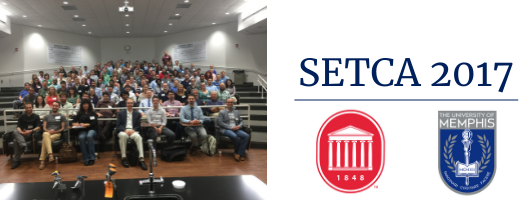Location
Coulter Hall, Room 211
Start Date
19-5-2017 8:10 AM
Description
Complete active space self-consistent field (CASSCF) methods are enormously important in quantum chemistry, as they allow for the description of states dominated by more than one electronic configuration. In CASSCF, the electronic structure of the active space is often represented by a configuration interaction (CI) expansion of the active-space wave function. Unfortunately, the exponential complexity of the full CI wave function severely limits the size of the active space that can practically be considered. For a large-active-space CASSCF algorithm, one must abandon CI in favor of an approach with more desirable scaling properties, such as the density matrix renormalization group (DMRG) or variational two-electron reduced-density method (v2RDM) methods. Using state-of-the-art semidefinite programming techniques and density-fitting approximations, we have developed a v2RDM-driven CASSCF procedure that can treat active spaces with 50 electrons in 50 orbitals and the simultaneous optimization of nearly 2000 orbitals. Analytic gradients are also available for the approach, and v2RDM-CASSCF-optimized bond lengths typically agree with those from configuration-based approaches to within a few hundredths of an angstrom. Lastly, excited electronic states can also be obtained within the v2RDM-CASSCF framework using an extended random phase approximation. However, a proper treatment of excitations from degenerate ground states requires the consideration of pure-state N-representability conditions.
Relational Format
Conference proceeding
Recommended Citation
DePrince, A. Eugene III, "IL1. Quantum Chemistry without Wavefunctions" (2017). Southeast Theoretical Chemistry Association Meeting (SETCA). 3.
https://egrove.olemiss.edu/setca/2017/schedule/3
IL1. Quantum Chemistry without Wavefunctions
Coulter Hall, Room 211
Complete active space self-consistent field (CASSCF) methods are enormously important in quantum chemistry, as they allow for the description of states dominated by more than one electronic configuration. In CASSCF, the electronic structure of the active space is often represented by a configuration interaction (CI) expansion of the active-space wave function. Unfortunately, the exponential complexity of the full CI wave function severely limits the size of the active space that can practically be considered. For a large-active-space CASSCF algorithm, one must abandon CI in favor of an approach with more desirable scaling properties, such as the density matrix renormalization group (DMRG) or variational two-electron reduced-density method (v2RDM) methods. Using state-of-the-art semidefinite programming techniques and density-fitting approximations, we have developed a v2RDM-driven CASSCF procedure that can treat active spaces with 50 electrons in 50 orbitals and the simultaneous optimization of nearly 2000 orbitals. Analytic gradients are also available for the approach, and v2RDM-CASSCF-optimized bond lengths typically agree with those from configuration-based approaches to within a few hundredths of an angstrom. Lastly, excited electronic states can also be obtained within the v2RDM-CASSCF framework using an extended random phase approximation. However, a proper treatment of excitations from degenerate ground states requires the consideration of pure-state N-representability conditions.



Comments
Download includes an expanded abstract with collaborators, institutional affiliations and cited references.